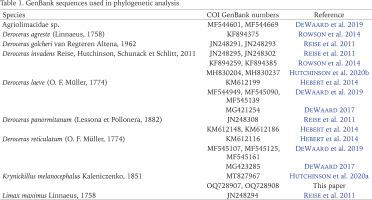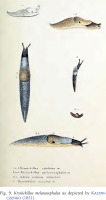Several distincive-looking slugs were spotted by the second author while examining a decaying log during amateur mycological observations in Kabaty Woods Nature Reserve in Warsaw, Poland. The slugs, measuring around 45 mm, were noticed for their bluish grey body with a characteristic deep black head and tentacles (Figs 1–4). The specimens were found on 13th November 2022, in an oak-hornbeam forest next to a Kanał Grabowski ditch and a recreational hiking trail used commonly by residents (52°08'00.2″N, 21°02'16.8″E).
Figs 1–4
Krynickillus melanocephalus: 1 – external appearance of individual collected in Warsaw on 15 November 2022; 2–4 – cooled slug before preservation in ethanol. Scale bars 1 mm. Photos: Anna Sulikowska-Drozd
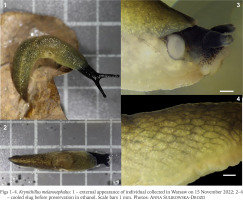
The author took photos and a video of one of the slugs and posted them on the iNaturalist website (https://www.inaturalist.org/observations/141913696, accessed on 5 April 2023). The app is a citizen science network that allows users to post observations, identify them with the aid of a Machine Learning algorithm, and cross-verify them by other users, including expert scientists. The slug observation was automatically suggested to be Krynickillus melanocephalus (Agriolimacidae), which was noticed by the (first) author. Igor Balashov, an app user and a malacologist from Ukraine, was asked to verify the identification. Although he generally agreed, he also recommended detailed anatomical analysis to distinguish it from similarly looking Deroceras caucasicum Simroth, 1902 (Agriolimacidae, likewise). Neither species had previously been reported in Poland.
Two days later, on 15th November 2022, two specimens were collected at the same spot for further identification. Another few living individuals were found there and left under the log. Additionally, a similarly looking slug was found and collected from a location on a hiking trail several dozen meters away (52°08'05.3″N, 21°02'06.7″E).
The identification was subsequently confirmed on an anatomical basis (Figs 5–7). In particular, collected specimens have cylindrical penises, without any external appendages. For every individual, the length of the penis is similar to spermatheca with its duct. These traits agree with the species description provided by Wiktor (2000). Reporting invasive specimens from Hungary, Turóci et al. (2020) noted that the K. melanocephalus penis consists of a thinner basal (distal) and a swollen apical portion. The specimens from Warsaw do not show this trait, having the penis of constant width, in accordance with Wiktor’s (2020) description.
Figs 5–7
Krynickillus melanocephalus: genitals of slugs collected in Warsaw on 15 November 2022. Abbreviations: p – penis, vd – vas deferens, ov – oviductus, bc – bursa copulatix. Scale bars 1 mm. Photos: Anna Sulikowska-Drozd
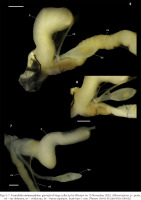
The initial identification of K. melanocephalus collected in Warsaw was also corroborated by mitochondrial cytochrome c oxidase (COI) DNA barcode. The sequences have been deposited in GenBank (accession numbers OQ728907, OQ728908). BLASTn analysis (Altschul et al. 1990) showed that the sequences are near-identical with the only one other sequence of K. melanocephalus available in GenBank (ID: MT827967). Both scored 100% sequence identity on 98% query cover, meaning that all three sequences are virtually indistinguishable, up to the trimming of their edges. Additionally, all other result alignments were less than 87% identical, which supports the anatomical identification. Maximum Likelihood tree of these three COI sequences and several other of agriolimacid species, obtained from GenBank (Fig. 8, Table 1) showed a well separated cluster of K. melanocephalus sequences, confirming species identification.
Fig. 8
Maximum Likelihood (ML) tree of COI sequences obtained from GenBank for Agriolimacidae species. The sequences were cut to 619 bp in length. Alignments were performed with ClustalW, implemented in BioEdit (Thompson et al. 1994). For alignments, HKY+G was specified as best nucleotide substitution model according to the Bayesian Information Criterion (Hasegawa et al. 1985, Kumar et al. 2016). The tree was built using MEGA7 (Kumar et al. 2016). Numbers next to the branches indicate bootstrap support above 50% calculated for 1000 replicates (Felsenstein 1985). The tree was rooted with Limax maximus COI sequence JN248294 deposited in GenBank by Reise et al. (2011)
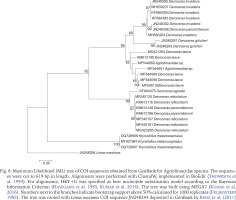
Krynickillus melanocephalus is a land slug of the family Agriolimacidae. It was first described by Kaleniczenko in 1851 based on the population from the Caucasus around the city of Stavropol, Russia (Kaleniczenko 1851) (Fig. 9). The natural range of the slug is the Caucasus, Crimea, Turkey and northern Iran (Wiktor 2000). In its native range it is mainly a forest species, occurring chiefly in the neighbourhood of water. During dry periods it hides in soil cracks (Kaleniczenko 1851), leaf litter, or under rocks and logs (Likharev & Wiktor 1980). Its body is dirty whitish, sometimes bluish grey, darker on the back. The front part of the body is covered by a mantle with brighter-rimmed breathing pore (pneumostome) on its rear end. Its characteristic trait is deep black head, tentacles, and nape (also the section under the mantle) (Wiktor 2000).
Since the 1990s, the species has been reported outside its native range: Germany (Meng & Bössneck 1999), further parts of Russia (Sysoev & Schileyko 2009) and Ukraine (Balashov 2016), Belarus (Ostrovsky 2017), Lithuania and Latvia (Dreijers et al. 2017), Estonia, Sweden (von Proschwitz 2020), Hungary (Turóci et al. 2020), and Slovakia (Čejka et al. 2021). In the iNaturalist database (https://www.inaturalist.org/observations?taxon_id=807716, accessed on 5 April 2023) there are also 15 records in Finland, the northernmost of the species’ range. Despite the presence in the neighbouring countries, the species has not yet been reported in Poland1.
K. melanocephalus is considered an invasive species (von Proschwitz 2020). In its introduced range, it is most commonly found in synanthropic habitats. Our record comes from a forest habitat within the administrative boundaries of the city of Warsaw. Despite the terrain being a legally protected area (Ministerstwo Leśnistwa i Przemysłu Drzewnego 1980), Kabaty Woods are intensively used as a recreation area, being almost entirely surrounded by residential areas. As much as determining the source of the introduction is impossible, the surroundings of the forest may suggest an introduction by humans.
Because this alien species has been recorded within a legally protected area, we find it necessary to discuss guidelines on future responses to similar occurrences. There is no legal basis for mandatory eradication of the population. K. melanocephalus is absent from lists of invasive alien species of the European Union or Poland (Rada Ministrów 2022, GDOŚ 2023). Nonetheless, as it is described as an invasive species (von Proschwitz 2020), actions should be taken to eliminate individuals from the protected area. We recommend manually picking up easily identifiable adult specimens and killing them humanely. We discourage the use of chemical approaches, as they do not seem to be effective or selective and pose high harm to the environment.
Learning from the cases of K. melanocephalus invasion in neighbouring countries, we suspect an incoming influx of species’ sightings in Poland. In the iNaturalist database there are records of the slug’s presence near the Polish border in three distinct regions: Kaliningrad Oblast (Russia), Brest and Grodno (Belarus) and Bardejov (Slovakia) (https://www.inaturalist.org/observations?taxon_id=807716, accessed on 5 April 2023). Information on new sightings should be reported to the Institute of Plant Protection – National Research Institute and the General Directorate for Environmental Protection. It is also recommended to inform the public about the presence and adverse effects of K. melanocephalus, as well as broader topics of species’ invasions, through press reports and popular science literature.
In the case of the first record of K. melanocephallus it is important to acknowledge the vital role of citizen science networks, as exemplified by two other reports of the same species by Barbato et al. (2021) and Turóci et al. (2020). In our case the iNaturalist network enabled to quickly identify and document the specimen. As citizen science networks enable connecting amateurs with the scientific community, they may greatly contribute to the malacology and biological natural sciences in general.

